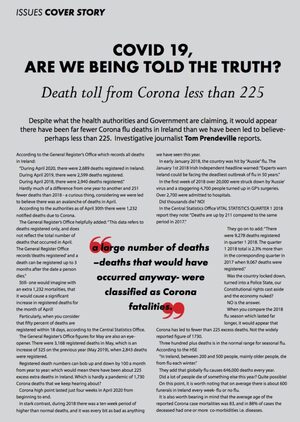

From top: Latest update on the Department of Health’s Covid-19 dashboard; Dublin Coroner Dr Myra Cullinane
This morning.
The latest Department of Health figures show that, as of April 15, there were 444 Covid-19 deaths in Ireland, 290 associated with residential settings, including 245 in nursing homes.
Last week, the department confirmed that when calculating its death toll, the department counts “any death that involves a positive Covid-19 test” and any person whose remains test positive for Covid-19 during a post-mortem.
This would appear to suggest that any person who has tested positive for Covid-19 will be listed as having died from Covid-19 regardless of the actual cause of death
Further to this…
This morning Paul Cullen reports in The Irish Times that the Dublin Coroner Dr Myra Cullinane has warned that “not all Covid-19 deaths are being reported as required by law“.
Mr Cullen reports:
…Dr Myra Cullinane has written to medical staff in hospitals and other locations who are responsible for completing death certificates saying they must comply with the requirement to report “any death in the context of proven or suspected” Covid-19 to her office.
Her warning comes amid concern over possible under-reporting of deaths from the virus, particularly outside hospitals. Analyses of online death notices in recent weeks have suggested a level of excess mortality not captured in official figures.
…In her letter, Dr Cullinane reminds medical staff of the requirement under the Coroners Acts to report virus deaths. She adds: “It has been drawn to my attention that such reporting is not taking place in all cases.”
Meanwhile, earlier on RTÉ’s Morning Ireland…
Broadcaster Dr Gavin Jennings asked Dr Siobhán Ní Bhriain, National Lead for Integrated Care with the HSE, if she’s “sure that all deaths for Covid-19 or suspected in care centres and in nursing homes are being reported as Covid-19 deaths“.
Ms Ní Bhriain replied:
“I couldn’t say with absolute certainty, Gavin, that they are being reported as such. I do, we do wonder, if at the early stages of the disease, when we didn’t suspect it was Covid, there may have been a couple of deaths that occurred early that would not have been typically Covid in terms of symptoms.
“But we have a review system in place to look back over all those deaths reporting, that were reported. And we will be reviewing that.”
Listen back to the interview in full here
Some Covid-19 deaths are not being reported, coroner warns (Paul Cullen, The Irish Times)
Related: 881 patients in acute hospitals with Covid-19, 448 suspected cases (RTÉ)
Previously: Counting ‘Every Death’ That ‘Involves A Positive COVID-19 Test’
Meanwhile.
More than nine in 10 people [in the UK] dying with coronavirus have an underlying health condition, figures from the Office for National Statistics show.
The ONS looked at nearly 4,000 deaths during March in England and Wales where coronavirus was mentioned on the death certificate.
In 91% of cases the individuals had other health problems.
The most common was heart disease, followed by dementia and respiratory illness.
On average, people dying also had roughly three other health conditions.
Coronavirus: Nine in 10 dying have existing illness (BBC)




















